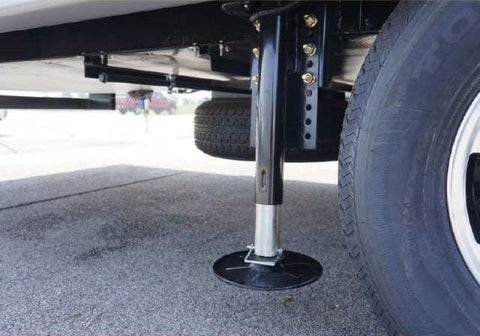
Are RV Wheel Chocks Necessary? Here's Everything YOU Need to Know about WHEEL CHOCKS!
Are RV wheel chocks necessary?
RV wheel chocks are not only recommended but are also necessary for your safety and the safety of your RV. Wheel chocks are small devices that prevent your RV from moving while parked, by keeping the wheels in place.
When parked on uneven terrain or inclines, RVs can roll or shift, even if the parking brake is engaged. In such situations, wheel chocks prevent the RV from moving, which can protect you and your vehicle from accidents.
In addition, many campsites and RV parks require the use of wheel chocks! They may even refuse to allow you to park your RV without them. So, it's always a good idea to have a set of wheel chocks on hand whenever you're traveling with an RV.
Do RV Wheel Chocks Work?
Yes, RV wheel chocks do work when used correctly. Wheel chocks are designed to prevent the wheels of your RV from rolling or shifting while parked, which can help to keep your RV and its occupants safe.
To ensure that your wheel chocks work effectively, it's important to choose the right size and type for your RV and the terrain on which you're parked. You should also position the chocks correctly, placing them snugly against the tires and making sure that they are level and secure.
It's also important to use wheel chocks in conjunction with other safety measures, such as the parking brake and leveling jacks, to ensure maximum stability and safety for your RV.
When used correctly, RV wheel chocks are a reliable and effective way to prevent your RV from moving while parked, and they are an essential safety item for anyone traveling with an RV.
How many wheel chocks do you need for an RV?
The number of wheel chocks you need for an RV depends on the size and weight of your RV, as well as the terrain on which you're parked. As a general rule, it's recommended that you use at least two wheel chocks, one for each side of the RV.
If you have a larger or heavier RV, or if you're parked on an incline, you may need to use more than two wheel chocks to ensure maximum stability and safety. Some RVers even choose to use four or more wheel chocks, placing them at each tire to create a "wheel chock triangle" for added stability.
Ultimately, the number of wheel chocks you need will depend on your individual circumstances and preferences, but it's always better to err on the side of caution and use more wheel chocks than you think you need.
Do you need to chock both sides of an RV?
Yes, it's recommended to use wheel chocks on both sides of an RV for maximum stability and safety. This is because using only one chock can still allow the RV to move or shift, especially if the terrain is uneven or there are external factors that could cause movement, such as wind or passing vehicles.
Using a chock on both sides of the RV helps to prevent the RV from rolling or shifting in either direction, which can provide added peace of mind for RVers and reduce the risk of accidents or damage to the RV.
So, if you're using wheel chocks to stabilize your RV, it's important to use them on both sides of the RV, placing one chock against each tire. This will help to ensure that your RV stays in place while parked, providing a safe and secure environment for you and your passengers.
What can I use instead of wheel chocks?
While it's always recommended to use wheel chocks for maximum stability and safety when parking your RV, there are a few alternatives that can be used in a pinch. Here are a few options:
- Blocks of wood or bricks: Using blocks of wood or bricks is not recommended as a long term solution. The safest way to park your RV is by using high quality Wheel Chocks and chocking your RV properly. However, you can use wooden blocks or bricks to prevent your RV from rolling or shifting while parked as a temporary solution, if wheel chocks are unavailable. Simply place the blocks or bricks against the tires on both sides of the RV, making sure that they are level and secure.
- Stabilizing jacks: Stabilizing jacks are designed to support the weight of your RV and keep it stable while parked. They can be placed under the frame of your RV, and then lowered to provide additional stability.
- Scissor jacks: Scissor jacks are similar to stabilizing jacks, but they are designed to provide vertical support to your RV. They can be placed under the frame of your RV and then cranked to lift the RV and provide additional stability.
- Leveling blocks: Leveling blocks can be used to level your RV on uneven terrain, but they can also provide additional stability when placed against the tires on both sides of the RV.



While these alternatives can be effective in certain situations, it's still recommended to use wheel chocks whenever possible for maximum stability and safety.
Other chock options to keep in mind are BAL X-Chocks, which are great for Travel Trailers. RV PandA carries nearly all top brands of wheel chocks products and accessories for chocking your RV - from Camco RV, to BAL Products, and Stromberg Carlson, Fastway, Ultra-Fab, Valterra, and MORE!

Overall, using wheel chocks is a simple and effective way to keep your RV stationary and safe while parked, and it's always better to be safe than sorry!
Order now from RVPandA.com and enjoy FREE Shipping on orders over $100*!
RV PandA makes RV living easy, so you can
enjoy more of the great outdoors!
Do you have a suggestion for the folks at RV PandA for a future blog? Let them know by emailing traveling@rvpanda.com
